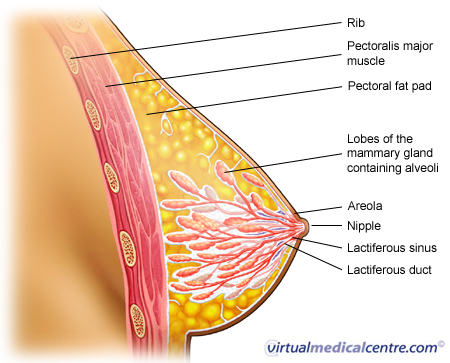- What are breasts and what is their function?
- Breast components
- Breast structure
- Nipple and areola structure and function
- Vasculature of the breast
- Breast changes during pregnancy
- Hormonal regulation effect on breasts
What are breasts and what is their function?

It is important for women to understand the normal anatomy and function of their breasts so that any abnormalities can be detected and treated.
Breast components
The breast consists of:
- Milk glands (lobules) that produce and supply milk
- Special ducts that transfer milk from the lobules to the nipple
- Nipple
- Areola (pink/brown pigmented region surrounding the nipple)
- Fat
- Connective (fibrous) tissue
Breast structure
Female breasts are rarely symmetrical. In most cases, a breast is usually slightly larger or smaller, higher or lower or of different shape to the other side. When fully developed, the female adult breast is composed of 15–20 lobes of branching glands. These lobes are separated by bands of connective tissue, which radiate out from the nipple like spokes from the middle of a bicycle wheel. There is lots of fat tissue within the breast. The amount of fat determines the size of the breast. The fatty tissue gives the breast its soft consistency.
The special glands in the breast are called tuboalveolar glands, which are modified sweat glands. Each of these glands end in a lactiferous duct (2–4 mm in diameter) and opens up through a small hole onto the nipple. Deep to the areola, each duct has a dilated part called the lactiferous sinus, in which milk can accumulate and remain in the nursing mother. Cells which are important in contraction movements, called myoepithelial cells, are present in the gland and help in secreting fluids.

Nipple and areola structure and function
The nipple and areola are the darker areas of the breast. The nipples contain no fat, hair or sweat glands. There are many smooth muscle fibres in tissues of the breast, which are specially arranged to help the nipple to become erect when stimulated. During puberty, the pigment in the nipple and areola increases and the nipple becomes more prominent.
Within the areola, there are sebaceous glands, sweat glands and modified mammary glands (glands of Montgomery). These glands produce small elevations on the areola surface. The sebaceous glands enlarge during pregnancy and secretes oily material, which acts as a lubricant for the areola and nipple.
Vasculature of the breast
Arteries carry oxygen-rich blood from the heart to the chest wall and the breasts, while veins take de-oxygenated blood back to the heart.
The arterial supply of the breast is from:
- Internal thoracic artery
- Lateral thoracic and thoracoacromial arteries
- Posterior intercostal arteries
Venous drainage of the breast is mainly through the axillary vein, and some drainage occurs through the internal thoracic veins.
Drainage of lymph (a clear fluid that travels through the body’s arteries, circulates through tissues to help clean them, and then drains away through the lymphatic system) through the breast is very important, especially in metastases involving breast cancer cells. Lymph runs from the nipple, areola and lobules into a special network, which then drains to the axillary lymph noses, parasternal and subclavicular nodes.
The nerve supply of the breast is derived from the intercostal nerves. Nerves convey sensory fibres to the skin of the breast so there is sensation of the breast, and nerve fibres also run to the blood vessels and smooth muscles within the breast.
Breast changes during pregnancy
During pregnancy, many changes occur in the breast, to prepare for the baby and produce milk. Cells in the glands of breast tissue change shape and increase in size and number. The areola enlarges and becomes darker.
Later in pregnancy, subsequent increases in breast size occur through cells which secrete milk products and these secretory products accumulating in the ducts. A special thick white/yellow fluid called colustrum is produced in the breast during the last few weeks of pregnancy and first few episodes of nursing. This is rich in protein and agents which protect the baby from harmful substances such as bacteria.
 |
For more information about pregnancy, including preconception advice, stages of pregnancy, investigations, complications, living with pregnancy and birth, see Pregnancy. |
Hormonal regulation effect on breasts
During puberty, growth and development of the breast occurs due to oestrogens and progesterones. After this development, changes in breast morphology occur during the ovarian cycle due to hormonal fluctuations.
During pregnancy, oestrogen and progesterone produced by the corpus luteum stimulate proliferation and development of the breast. Prolactin (produced by the adenohypophysis), somatomammotrophin from the placenta and adrenal corticoids also play a role during pregnancy.
After delivery, levels of circulating hormones decrease with degeneration of the corpus luteum and the placenta. Milk secretion is stimulated by increased prolactin (as a neurohormonal response to suckling) and adrenal cortical steroids. Oxytocin is also produced, which stimulates contraction of myoepithelial cells in the mammary glands to eject milk.
With absence of ovarian hormones after menopause, breast glands atrophy and secretory cells of the alveoli degenerate. Connective tissue also shows degenerative changes with a decrease in stromal cells and collagen.
More information
 |
For more information on breast cancer, types of breast cancer and its investigations and treatments, as well as some useful videos, see Breast Cancer. |
References
- Ross MH, Gordon GI, Pawlina W. Histology : A Text & Atlas, USA: Lippincott Williams & Wilkins; 2003.
- Moore KL, Dalley AF. Clinically Orientated Anatomy. Canada: Lippincott Williams & Wilkins; 1999.
- Impey L. Obstetrics & Gynaecology. Australia: Blackwell Publishing Ltd: 2004
- Ameerally P. Anatomy. UK: Harcourt Publishers Ltd; 2000.
All content and media on the HealthEngine Blog is created and published online for informational purposes only. It is not intended to be a substitute for professional medical advice and should not be relied on as health or personal advice. Always seek the guidance of your doctor or other qualified health professional with any questions you may have regarding your health or a medical condition. Never disregard the advice of a medical professional, or delay in seeking it because of something you have read on this Website. If you think you may have a medical emergency, call your doctor, go to the nearest hospital emergency department, or call the emergency services immediately.







